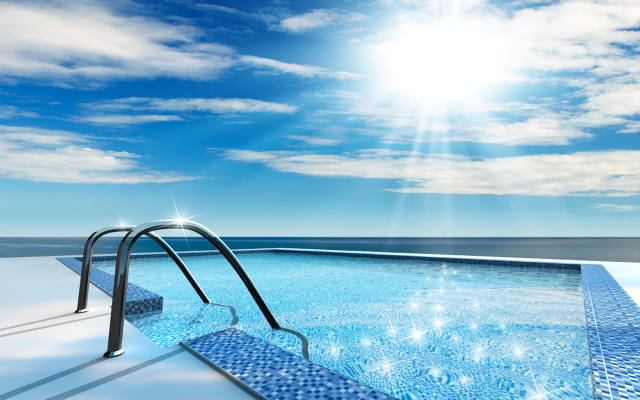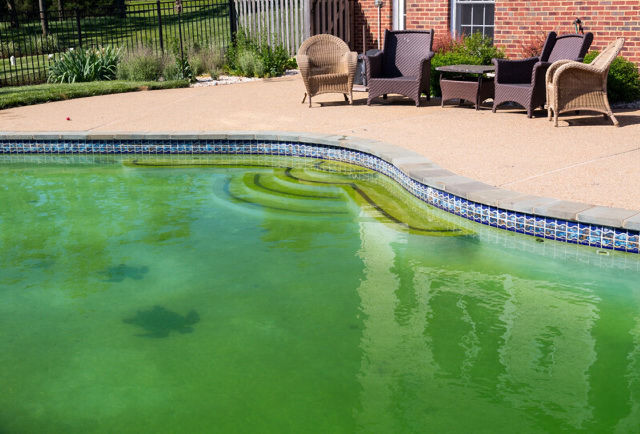From cyanuric acid to oxidizers, bromine, and chlorine, you work with an assortment of pool chemicals to keep the water clean. Are you using muriatic acid as well? What is muriatic acid and why do you need it for your pool?
Muriatic acid is also known as spirits of salt. The pool-grade variety has less hydrogen chloride than hydrochloric acid. It comes in handy for reducing pool pH, cleaning surfaces, and acid washing pools.
If you want to learn even more about muriatic acid for swimming pools, this guide will tell you everything you need to know. Make sure you keep reading!

Article Contents
What Is Muriatic Acid?
First, let’s discuss muriatic acid so you know what you’re working with.
The word muriatic means a salt-containing substance, which is why an old nickname for muriatic acid is spirits of salt, as we mentioned in the intro.
Muriatic acid has a lot of purposes. The stuff can pickle steel, clean some household surfaces, process leather, produce gelatin, and synthesize polyvinyl chloride or vinyl chloride.
Most importantly for the sake of this article, muriatic acid can affect your swimming pool in a myriad of ways that we’ll talk more about shortly.
Muriatic acid is a less pure weaker type of hydrochloric acid. You can usually buy the stuff in gallon jugs, but it might be available as a powder as well.
You don’t want to use any other type of muriatic acid but the pool-grade stuff. We can’t stress enough that muriatic acid is quite a strong and corrosive acid, so using the wrong concentration can be dangerous.
Fortunately, we’ll talk more about how much muriatic acid to use later as well.
What Does Muriatic Acid Do for Pools?
Why use muriatic acid in your pool at all? The acid has several handy uses that make it a chemical worth keeping among your pool supplies.
Reduces pH and Alkalinity
Once your pool’s pH levels exceed 7.8, the water is more alkaline than it’s supposed to be. A slew of side effects will emerge.
Anyone who swims in the pool can develop rashes and skin irritation. Your pool water can become cloudy, and the rate of scale on metal surfaces will increase.
Most importantly, high pool alkalinity renders chlorine ineffective.
Muriatic acid lowers the pH and alkalinity levels in your swimming pool.
Cleans Cartridge Filters
Do you have a cartridge filter in your pool? You might use distilled vinegar to get rid of any algae, mold, mildew, and hard water stains on the cartridge, right?
The issue with this method is that you usually have to use a lot of distilled vinegar for it to be effective, so it’s sort of wasteful.
With muriatic acid, a little will go a much longer way in cleaning your cartridge filter.
Further Reading: How to Clean Pool Cartridge Filter (Using Muriatic Acid)
Acid Washes Pool Surface
Every now and again, pool owners opt to acid wash the pool.
This treatment mixes water and muriatic acid onto the surface of the pool water to remove accumulations and grime such as algae or hard water stains.
Well, the paragraph above says it all. Muriatic acid is the chemical of choice for acid washing, so you’ll need it if your pool requires this treatment.
Removes Stains from Concrete and Pool Surrounds
We touched on how muriatic acid can clean some household surfaces, usually when diluted first.
You can also rely on muriatic acid to remove unsightly stains from your concrete pool deck as well as the pool surrounds. Your pool will have never looked better!
When to Use Muriatic Acid in a Pool
Is your swimming pool a good candidate for muriatic acid? Here’s how to be sure.
High pH and Alkalinity
Have you tried sodium bisulfate, also known as pH Down or pH Decreaser, to control your pool’s pH but nothing is sticking? Does the pH level keep rising and you’re concerned because the water is starting to get cloudy?
Try using muriatic acid. It’s stronger and faster working than sodium bisulfate. It should banish your pool’s high alkalinity and pH quickly.
Stained Pool
You can scrub, scour, and put all the elbow grease you have into making your pool deck tidy, but you think your pool looks worse than ever. Muriatic acid can really do the trick, and we’ll tell you how to use it a little bit later.
Related Reading: How Much Muriatic Acid To Lower Pool pH & Alkalinity
What Strengths Does Muriatic Acid Come In? Which Is the Best Strength?
Muriatic acid comes in several strengths starting as low as 14.5 percent and as high as 34.6 percent.
That said, whether you’re shopping around online or in person at your favorite pool supply store, you’re most likely to see two muriatic acid concentrations. These are 15.7 percent on the lower end and 31.45 percent on the higher end.
Which concentration should you use?
We’d recommend a concentration between 14.5 percent and 15.7 percent for your swimming pool.
You can always increase the amount of muriatic acid you add, especially in a scenario where you’re trying to treat high pH and alkalinity.
This is another good opportunity to remind you that muriatic acid is a highly corrosive chemical. Using the stuff in too high of a concentration can increase your risk of respiratory tract inflammation and infection as well as nose and eye inflammation.
The lower concentration of muriatic acid will work well.
Muriatic Acid vs. Hydrochloric Acid
Although muriatic acid is technically a type of hydrochloric acid, the two products are not identical. That’s why we thought it’d be a good idea to take this section to explain the differences.
Pool-grade muriatic acid has less hydrogen chloride than hydrochloric acid. Muriatic acid is also diluted compared to hydrochloric acid.
How Often Should You Add Muriatic Acid to Your Pool?
You bought a low-strength jug of muriatic acid to be on the safe side, but you realize that you have no idea how much of the stuff to add to your pool at once.
Since the muriatic acid you bought is a lower concentration, you’ll need to add more in than if you had a higher concentration of muriatic acid.
That said, you still don’t want to pour gallons of low-grade muriatic acid into your pool without measuring.
If your pool is between 10,000 gallons, then you’ll need around 5-7 fl oz of muriatic acid to lower the pH by 0.1.
You should wait at least 24 hours from the last time you added the acid before pouring in more.
Related Reading: Can I Add Muriatic Acid All at Once? | How to Safely Add
How to Use Muriatic Acid
As promised, in this section, we want to describe how to use muriatic acid for its two main purposes, controlling pH levels and removing stains.
To Lower pH
Before you can treat a high pool pH with muriatic acid, you need to select the right quantity of acid based on two factors, the size of your pool and your pool’s current pH.
We’ll use a 10,000-gallon pool as an example.
If your pool has a pH of 7.6 to 7.8, then add 12 ounces or 340 milliliters of muriatic acid. For a pH reading of 7.8 to 8.0, use 16 ounces or 454 milliliters of acid.
If the pH of your swimming pool is exceptionally high at 8.0 to 8.4, you’ll need 24 ounces or 680 milliliters of muriatic acid. Use a quart or 907 milliliters for a pH reading over 8.4.
Before you go ahead and dump the muriatic acid in, turn your pool pump on to get the water circulating. Let the pump run for at least a half-hour after you pour the muriatic acid in to encourage more circulation.
After several hours, use a pH testing kit to gauge your pool’s pH levels. You’re aiming for 7.4-7.6. If you’re pleased with the pH, then you’re all finished.
To Remove Stains
What if it’s stains that are marring your pool deck or pool walls? You won’t use muriatic acid in quite the same way as to combat a high pH.
In a spray bottle, combine water and muriatic acid in a 1:16 ratio. That is 1 part acid and 16 parts water. You want the muriatic acid diluted to prevent further damage to your pool surfaces.
Mist the stained surface and then allow the muriatic acid mixture to sit untouched for at least 10 minutes but ideally 15 minutes.
Repeat if needed. You can also use a nylon brush to rub in the muriatic acid if a stain doesn’t want to come out. Be sure to throw away the brush when you’re finished. And remember to wear thick acid-resistant gloves, safety glasses, and long sleeve clothing.
You can now clean the surface of all muriatic acid residue and be sure not to get the residue in your pool.
Does Muriatic Acid Kill Algae?

Your swimming pool is looking mighty green lately, and you attribute the discoloration to algae. Can muriatic acid help and kill algae?
Muriatic acid isn’t used for direct algae control. It’s not an algaecide.
However, since muriatic acid is used to keep the pH and total alkalinity from rising too high, in a non-direct way, muriatic acid is essential to control and kill algae.
Related Reading:
Green Pool – Guide to Easily Preventing & Removing Pool Algae
Muriatic Acid Vs Sodium Bisulfate (Dry Acid) For Pools
The Easiest Ways to Remove Calcium Deposits from Pool Tiles


Very nicely written and helpful article – thank you!